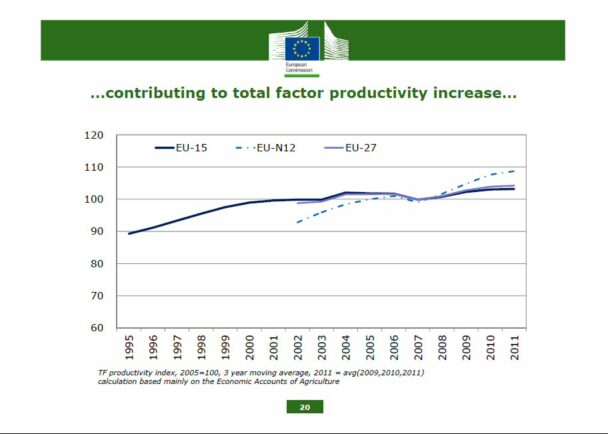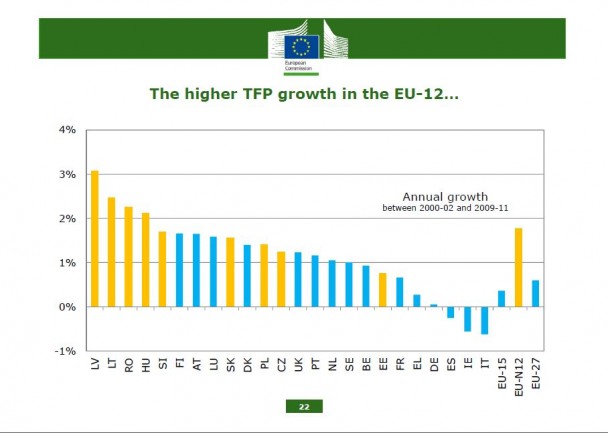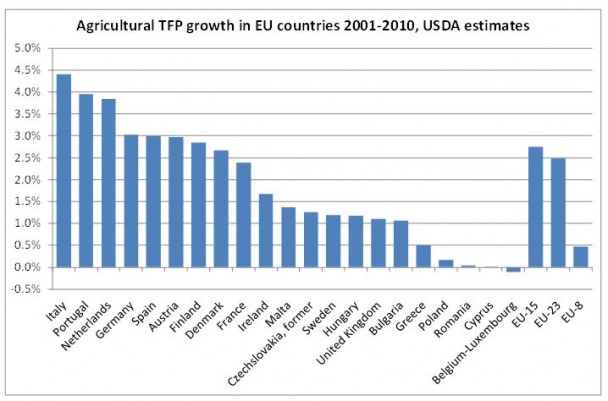Agricultural growth can come about through bringing new resources into production (new land, extension of irrigation, or input intensification per hectare) or through raising the productivity of existing resources. The appropriate measure of productivity growth in this context is Total Factor Productivity (TFP) growth, which is defined as the aggregate quantity of outputs produced by the agricultural sector divided by the aggregate quantity of inputs used to produce those outputs.
This measure contrasts with partial productivity measures such as growth in labour productivity or land productivity (yields per hectare) because an increase in these partial productivity measures can be achieved by increasing the intensity of use of other inputs (for example, crop yields can be increased by applying greater amounts of fertiliser or using more labour). Thus, partial productivity indicators do not measure ‘true’ productivity growth.
A higher level of TFP in agriculture can mean achieving greater output for the same inputs or using fewer inputs for the same level of output. Given the growth in global food demand and the need to minimise the additional demands on resources such as land and water, as well as intermediate inputs such as fertilisers and chemicals for environmental reasons, increasing the growth of TFP in agriculture should be a policy priority.
Indeed, the first of the five objectives for the Common Agricultural Policy set out in the Treaty of Rome and incorporated unchanged into the latest Lisbon Treaty is “to increase agricultural productivity by promoting technical progress and by ensuring the rational development of agricultural production and the optimum utilisation of the factors of production, in particular labour”.
Measuring TFP in EU agriculture
However, despite its policy importance, very little is known about TFP developments in European agriculture. In the early 2000s, Eurostat initiated an effort to develop a Multi-Factor Productivity (MFP) index for agriculture based on the Economic Accounts for Agriculture (EAA). The MFP index is similar to the TFP in that it compares the growth in agricultural output to the growth in a bundle, but not all, agricultural inputs. In particular, the Eurostat index did not take account of changes in land use for computational reasons.
The Eurostat index was published for a couple of years in the early 2000s (it was included in the annual Income from Agricultural Activity reports, for further details see this paper) but was then discontinued.
The need for a TFP index has become topical again following the 2013 CAP reform which puts greater emphasis on the need for monitoring and evaluating the effects of agricultural policy, including the new European Innovation Partnership for Agricultural Productivity and Sustainability (EIP-Ag). One of the indicators to be used to measure the impact of EIP-Ag is the growth in agricultural TFP, and it is included in the set of impact indicators being prepared by DG Agri where the new indicator is described.
The calculation of TFP growth faces many difficulties in terms of conceptual and methodological issues and data availability (for a discussion of these issues, see my earlier post on changes in global agricultural productivity growth). This is illustrated by comparing the preliminary results from DG AGRI’s computations (taken from a presentation by Tassos Haniotis at an IATRC symposium on agricultural productivity last year) with data from a newly-released USDA database on international agricultural productivity growth which also computes TFP measures for EU countries (I am grateful to David Blandford of Penn State University for drawing my attention to this database).
DG AGRI’s TFP measure
We first look at the DG AGRI findings on TFP growth in EU agriculture. As an approximate rule of thumb, the normal expectation of TFP growth in agriculture is around 2% per annum. The first chart below shows that from 1995 until about 2002, TFP growth in the EU-15 was around 1.6% per annum. However, since then EU-15 TFP growth in agriculture has stagnated, growing by only around 0.3% per annum over the period 2002 to 2011.
The only bright spot has been TFP growth in the new member states, which averaged around 1.6% growth per annum over the 2002 to 2011 period. However, these countries account for a relatively minor share of total agricultural output in the EU, so TFP growth in the EU-27 over the past decade was a disappointing 0.6% per annum. Note that to smooth out year-to-year variations in TFP because of yield fluctuations due to weather, the data are smoothed by using three-year averages, so the 2011 data is an average for the years 2009, 2010 and 2011.

TFP growth by individual country is shown in the second chart taken from the Haniotis presentation. This shows the impressive productivity performance of some of the new member states on the left-hand side (the five countries with the highest TFP growth over the 2001 to 2010 period (here I take the mid-year of the three year average rather than the end-year to make clear the similarity of the periods shown with the USDA data below) are all new member states, shown with yellow bars. Finland, Austria, Luxembourg and Denmark are the countries from the old EU-15 member states with the best TFP performance, with Spain, Ireland and Italy showing negative TFP growth over this period.

EU agricultural TFP growth according to USDA data
The other source of information on EU agricultural productivity growth is the USDA International Agricultural Productivity database (Incidentally, these are also the data underlying the Global Harvest Initiative’s annual GAP® report discussed in my earlier post).
The purpose of this database is to provide agricultural productivity growth rates on a global basis for as wide a number of countries as possible, so a comparable methodology based on FAOSTAT data is used. The approach is, in principle, the same as that used by DG AGRI, but the results could not be more different.
According to the USDA data, agricultural TFP growth in the EU-23 (for lack of long-term consistent data, the three Baltic EU countries and the countries of the former Yugoslavia Slovenia and Croatia are omitted, while the Czech Republic and Slovakia are grouped together) has actually been accelerating over the past decade. Furthermore, this acceleration in agricultural TFP growth has been particularly pronounced in the EU-15, while TFP growth in the new member states has slowed down more recently.
Specifically, agricultural TFP growth rates for the EU-23 according to the USDA estimates were 2.1% for the decade 1991-2000, 2.2% for the period 2001-5 and 3.1% for the period 2006-2010 (these figures compare to 1.8% in the 1970s and 1.5% in the 1980s). I have constructed all the averages quoted here as weighted averages where each individual country’s TFP growth rate in the group has been weighted by its average share of the group’s total agricultural output value in current prices taken from Eurostat for the years 1999-2001).
The corresponding figures for the EU-15 were 2.2% for the decade 1991-2000, 2.3% for the period 2001-5 and a whopping 3.5% for the period 2006-2010 (these figures compare to 2.0% in the 1970s and 1.6% in the 1980s).
The new member states show a different pattern. The corresponding figures for the EU-8 were 1.0% for the decade 1991-2000, 1.2% for the period 2001-5 and a disappointing 0.5% for the period 2006-2010 (these figures compare to 0.7% in the 1970s and 0.7% in the 1980s).
Thus, according to the USDA figures, productivity growth in the new member states has been consistently lower than in the old member states, and the gap has grown much bigger in the most recent period. The figure below shows the data for individual member states for the same decade as for the DG AGRI chart above. There is almost a perfect inverse correlation with the DG AGRI data.

Over the decade of the 2000s, Italy, Portugal, Netherlands, Germany, Spain and Austria all had TFP growth of 3% or more, according to the USDA data. Indeed, during the second half of the period, TFP growth in Italy, Portugal and Netherlands reached 5% and very close to that in Austria. Output growth in these calculations has been smoothed statistically to reduce the impact of weather-related yield variation from year to year, so these calculated high rates of TFP growth are very impressive. The disappointing performance of TFP growth in the new member states emerges clearly from the chart.
Why is our knowledge of productivity growth in EU agriculture so uncertain?
Without much more detailed analysis, it is hard to know why these two different sources tell such very different stories about agricultural productivity growth in Europe. Both use information on the growth of agricultural outputs and inputs over the 2001-2010 period which are then weighted to form the aggregate total output and total input indices from which TFP growth is derived as the change in the ratio over time.
The differences can be due to differences in the volume measures for the individual outputs and inputs, to differences in the weights used for aggregation, and to differences in the index number methodology adopted to create the TFP index.
The USDA figures build on FAOSTAT data for outputs and inputs while the DG AGRI figures build on the Eurostat EAA accounts. The latter are much more detailed than those available in FAOSTAT particularly for input use. The weights used for aggregation are in principle value shares. These shares are notoriously difficult to calculate particularly for the farmer-supplied inputs of own labour, capital and land. But because the trends in these inputs are vastly different in the EU (for example, a dramatic fall in farm labour compared to steady increases in capital input), the weights attached to these respective inputs will greatly influence the final TFP estimate. The weights are also influenced by the index number methodology used.
The stories told by these different indicators of TFP growth in EU agriculture are so different that it will be very important to investigate the reasons why these differences arise. The USDA database is highly transparent which should facilitate such a comparison. I understand that DG AGRI plan to release details of their TFP estimates later this year which may allow the reasons for these differences to be more fully assessed.
This post was written by Alan Matthews.



I have a question regarding “true” productivity. Are there combinatorial thresholds which gives stepwise jumps in productivity up to an optimum?
For instance for a given protein you need a certain amount of amino acids, consisting of certain amounts of N, C, P and so forth. To build these proteins you also need certain amounts of solar energy and H2O.
Then there is no use in throwing enormous amounts of fertilizer if you do not get enough water and sun to sustain the available nutrient base. This just gets p-ssed out into the oceans. But if you are lucky to get a season with optimal conditions and nutrient uptake then you will have a splendid year.
Each part of the formula needs to be met and overdoing one part will not increase yield if the other parts are missing.
If you each year come closer and closer to the local average optimum (sun hours, soil type, average rain) you increase the yield until you hit the “true” optimum.
Certain countries can have reached their optimum already while others still have parts of the equation they can improve on.
@Patte
Thanks for this query. You are certainly right that, for a particular technology, there are limiting factors and if you reach the boundary of a limiting factor, then adding additional factors will have no or only a limited effect on output.
However, for the macro-level productivity indices I am discussing in this post, these very specific issues get averaged out across technologies, across crops and across farms, so we tend to observe a much smoother evolution of the TFP index (apart from the contribution of weather variations which can lead to significant fluctuations in the index from year to year unless this is statistically smoothed).
The second part of your comment draws attention to the useful distinction between the technological frontier at a point in time, and where farmers are with respect to that frontier. As you rightly observe, many farmers can still improve their efficiency with respect to the existing optimum. In addition, however, through the efforts of agricultural researchers and farmers it is possible to push out the technological frontier over time. Thus the TFP index is a combination of (a) the extent to which farmers are closing in on the frontier (improving their efficiency) and (b) the speed with which the frontier itself is shifting (which is the ‘true’ measure of technical progress). Statistical techniques exist using farm level data which allow us to undertake this decomposition for different types of farming systems.